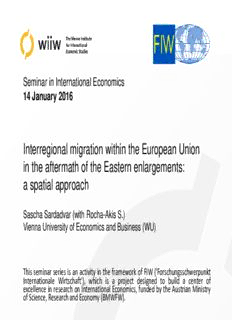
Interregional migration within the European Union in the aftermath of the Ea PDF
Preview Interregional migration within the European Union in the aftermath of the Ea
Seminar in International Economics 14 January 2016 Interregional migration within the European Union in the aftermath of the Eastern enlargements: a spatial approach Sascha Sardadvar (with Rocha-Akis S.) Vienna University of Economics and Business (WU) This seminar series is an activity in the framework of FIW ('Forschungsschwerpunkt Internationale Wirtschaft'), which is a project designed to build a center of excellence in research on International Economics, funded by the Austrian Ministry of Science, Research and Economy (BMWFW). Interregional Migration within the European Union in the Aftermath of the Eastern Enlargements: A Spatial Approach Sascha Sardadvar (Vienna University of Economics and Business) Silvia Rocha-Akis (Austrian Institute of Economic Research) wiiw-FIW-Seminar in International Economics 14-January-2016 Contents Part I : paper presentation Part II: recent developments and challenges 2 Part I Paper presentation Motivation and objectives of the study The model framework Spatial econometric specification Results 3 Motivation EU emphasises the benefits of inter-regional migration and the need of mobilising its existing human resources. Enlargement of the EU led to statistically increased wage disparities. Studies on interregional migration that include EU15 and NMS are scarce. 4 Objectives Develop a model that simultaneously considers source and destination regions. Transform the model into a spatial econometric specification that accounts for the role of distance. Identify the determinants of interregional migration and the role of distance. 5 ² rrr below -0.15% -0.15% to less than 0% 0% to 0.1% over 0.1% to 0.3% over 0.3% to 0.5% over 0.5% to 0.8% over 0.8% Average yearly net migration rates 2006-2008; Data source: Eurostat 0 245 490 980 Kilometers Model assumptions Interdependence: If a potential migrant decides to take action because the value of a particular variable within the destination region is expected to increase his or her utility, then it must be that he or she prefers that value relative to the value in other regions. Distance: Affects migration patterns, as it increases (i) the direct costs of moving as such, (ii) opportunity costs, (iii) information costs, (iv) psychic costs and, furthermore, (v) migrants often follow past migrants, who may have moved to near destinations. 7 Respecification of Greenwood’s (1978) model X X ... i,t 1 1,i,t1 2 2,i,t1 X X ... i,t 1 1,i,t1 2 2,i,t1 i,t i,t i,t O Out-migration I In-migration M Net-migration X Explanatory variable β, γ Coefficients In-migration and out-migration n w i,t ij j,t j1 n w 1j ij i1 n n I O i,t i,t i1 i1 w weighting variable
Description: